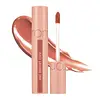What's inside
What's inside
 Key Ingredients
Key Ingredients

 Benefits
Benefits

 Concerns
Concerns

No concerns
 Ingredients Side-by-side
Ingredients Side-by-side

Water
Skin ConditioningGlycerin
HumectantSorbitol
HumectantEthylhexyl Hydroxystearate
EmollientSqualane
EmollientHydroxyethyl Acrylate/Sodium Acryloyldimethyl Taurate Copolymer
Emulsion StabilisingPhenoxyethanol
PreservativeDiisostearyl Malate
EmollientPEG-60 Hydrogenated Castor Oil
EmulsifyingPolyglyceryl-2 Triisostearate
EmulsifyingPolysorbate 60
EmulsifyingEthylhexylglycerin
Skin ConditioningSorbitan Isostearate
EmulsifyingAlumina
AbrasiveCI 77891
Cosmetic ColorantIron Oxides
CI 15850
Cosmetic ColorantCI 45410
Cosmetic ColorantCI 17200
Cosmetic ColorantCI 19140
Cosmetic ColorantCI 15985
Cosmetic ColorantCI 42090
Cosmetic ColorantWater, Glycerin, Sorbitol, Ethylhexyl Hydroxystearate, Squalane, Hydroxyethyl Acrylate/Sodium Acryloyldimethyl Taurate Copolymer, Phenoxyethanol, Diisostearyl Malate, PEG-60 Hydrogenated Castor Oil, Polyglyceryl-2 Triisostearate, Polysorbate 60, Ethylhexylglycerin, Sorbitan Isostearate, Alumina, CI 77891, Iron Oxides, CI 15850, CI 45410, CI 17200, CI 19140, CI 15985, CI 42090
Water
Skin ConditioningOctyldodecanol
EmollientDimethicone
EmollientAlcohol Denat.
AntimicrobialAcrylates Copolymer
Polysorbate 60
EmulsifyingEthylcellulose
Behenyl Alcohol
EmollientPentylene Glycol
Skin ConditioningSodium Acrylate/Sodium Acryloyldimethyl Taurate Copolymer
Emulsion StabilisingSilica
AbrasiveSorbitan Stearate
EmulsifyingIsohexadecane
EmollientDiisostearyl Malate
EmollientPhenoxyethanol
PreservativeCI 77891
Cosmetic ColorantPolyglyceryl-2 Triisostearate
EmulsifyingPolysorbate 80
EmulsifyingCI 77491
Cosmetic ColorantCI 77492
Cosmetic ColorantParfum
MaskingCI 77499
Cosmetic ColorantSorbitan Oleate
EmulsifyingAroma
Trisodium Ethylenediamine Disuccinate
Ethylhexylglycerin
Skin ConditioningCI 15850
Cosmetic ColorantPolyglyceryl-2 Diisostearate
EmulsifyingCI 17200
Cosmetic ColorantCI 15985
Cosmetic ColorantCI 42090
Cosmetic ColorantButylene Glycol
HumectantActinidia Chinensis Fruit Extract
EmollientCarica Papaya Fruit Extract
Skin ConditioningCitrus Paradisi Fruit Extract
Skin ConditioningCocos Nucifera Fruit Extract
EmollientMangifera Indica Fruit Extract
Skin ConditioningPsidium Guajava Fruit Extract
AstringentWater, Octyldodecanol, Dimethicone, Alcohol Denat., Acrylates Copolymer, Polysorbate 60, Ethylcellulose, Behenyl Alcohol, Pentylene Glycol, Sodium Acrylate/Sodium Acryloyldimethyl Taurate Copolymer, Silica, Sorbitan Stearate, Isohexadecane, Diisostearyl Malate, Phenoxyethanol, CI 77891, Polyglyceryl-2 Triisostearate, Polysorbate 80, CI 77491, CI 77492, Parfum, CI 77499, Sorbitan Oleate, Aroma, Trisodium Ethylenediamine Disuccinate, Ethylhexylglycerin, CI 15850, Polyglyceryl-2 Diisostearate, CI 17200, CI 15985, CI 42090, Butylene Glycol, Actinidia Chinensis Fruit Extract, Carica Papaya Fruit Extract, Citrus Paradisi Fruit Extract, Cocos Nucifera Fruit Extract, Mangifera Indica Fruit Extract, Psidium Guajava Fruit Extract
 Reviews
Reviews

Ingredients Explained
These ingredients are found in both products.
Ingredients higher up in an ingredient list are typically present in a larger amount.
Ci 15850 is the pigment color red. It is an azo dye and created synthetically.
Azo dyes need to be thoroughly purified before use. This allows them to be more stable and longer-lasting.
This ingredient is common in foundations, lipsticks, and blushes. This color is described as brown/orangey red.
It has many secondary names such as Red 6 and Red 7. According to a manufacturer, Red 6 usually contains aluminum.
Learn more about CI 15850Ci 15985 is a dye made from petroleum. It is synthetically created and approved by the FDA for use in foods and cosmetics.
The color of this dye is orange/yellow.
This ingredient can be found in makeup, sun care, and skincare.
Learn more about CI 15985Ci 17200 is a synthetic reddish-purple dye.
Ci 42090 is a synthetic dye created from petroleum. It is used to give a bright blue color to cosmetics, medicine, and food.
Ci 77891 is a white pigment from Titanium dioxide. It is naturally found in minerals such as rutile and ilmenite.
It's main function is to add a white color to cosmetics. It can also be mixed with other colors to create different shades.
Ci 77891 is commonly found in sunscreens due to its ability to block UV rays.
Learn more about CI 77891Diisostearyl Malate is an emollient and most often used in lip products. It comes from isostearyl alcohol, a fatty acid, and malic acid, an AHA.
As an emollient, Diisostearyl Malate helps create a thin film on your skin to trap moisture in. This helps keep your skin soft and smooth.
Ethylhexylglycerin (we can't pronounce this either) is commonly used as a preservative and skin softener. It is derived from glyceryl.
You might see Ethylhexylglycerin often paired with other preservatives such as phenoxyethanol. Ethylhexylglycerin has been found to increase the effectiveness of these other preservatives.
Phenoxyethanol is a preservative that has germicide, antimicrobial, and aromatic properties. Studies show that phenoxyethanol can prevent microbial growth. By itself, it has a scent that is similar to that of a rose.
It's often used in formulations along with Caprylyl Glycol to preserve the shelf life of products.
This ingredient is a form of glycerin with emulsifying and emollient properties.
As an emulsifier, this ingredient helps keep products together while adding a thick texture. The manufacturer states this ingredient has emollient properties. Emollients help keep the skin hydrated by trapping moisture in.
Polyglyceryl-2 Triisostearate is created by reacting diglycerin and isostearic acid. Due to the isostearic acid base, it may not be safe for Malassezia or fungal acne.
Learn more about Polyglyceryl-2 TriisostearatePolysorbate 60 is used to help stabilize products. It is a surfactant and emulsifier. These properties help keep ingredients together in a product. Surfactants help reduce surface tension between ingredients with different states, such as liquids and solids. Emulsifiers help prevent oils and waters from separating.
Polysorbate 60 is sorbitol-based and created from the ethoxylation of sorbitan. Ethoxylation is a chemical reaction used to add ethylene oxide. Sorbitan is a the dehydrated version of sorbitol, a sugar found in fruits.
In this case, the 60 comes from reacting 60 units of ethylene oxide with sorbitan.
Polysorbates are commonly used in medicine and foods.
Learn more about Polysorbate 60Water. It's the most common cosmetic ingredient of all. You'll usually see it at the top of ingredient lists, meaning that it makes up the largest part of the product.
So why is it so popular? Water most often acts as a solvent - this means that it helps dissolve other ingredients into the formulation.
You'll also recognize water as that liquid we all need to stay alive. If you see this, drink a glass of water. Stay hydrated!
Learn more about Water